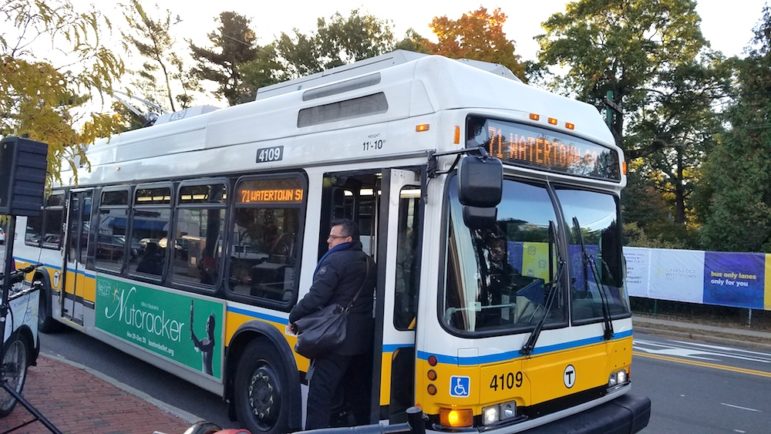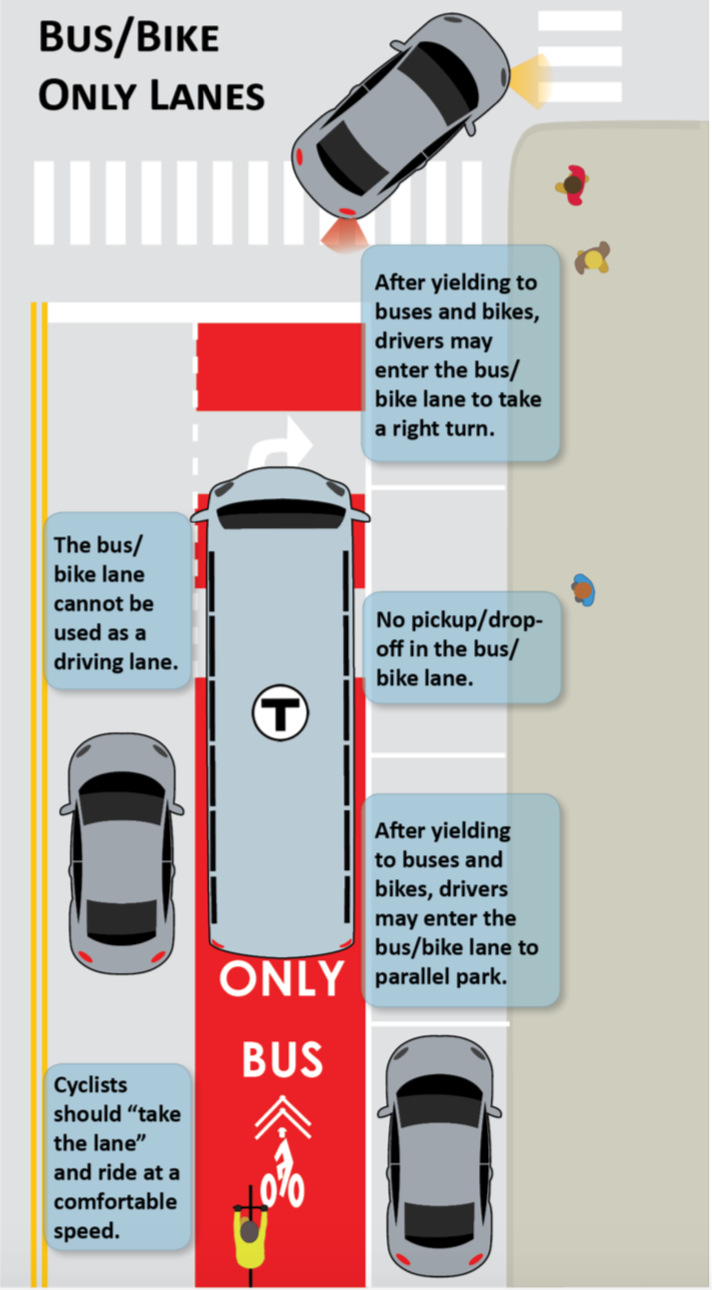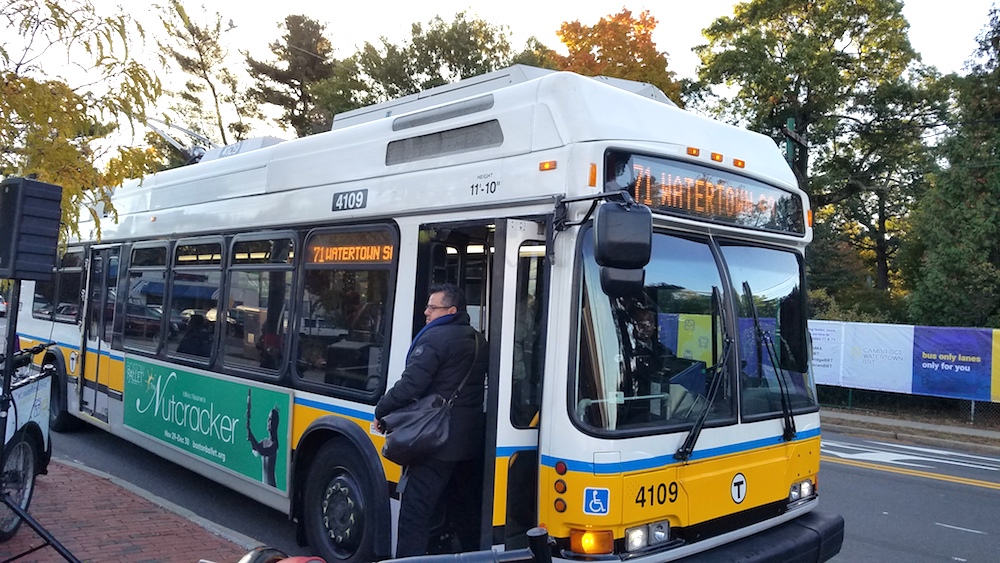
The following information was provided by the Town of Watertown:
Evaluation of the Cambridge-Watertown Mt. Auburn Street Bus Priority Pilot shows improved travel time and service reliability for 12,000+ daily MBTA bus and shuttle riders along Mt. Auburn Street, west of Fresh Pond Parkway.
The pilot, implemented in October 2018, introduced bus rapid transit elements, including segments of bus-only lanes, transit signal priority, and in-bound queue jump lanes, with the aim of improving bus reliability and enhancing overall traffic flow along the corridor.
According to post-implementation real-time bus performance data, traffic counts, and responses to municipal surveys:
- MBTA route 71 and 73 riders save 4-5 minutes on average during morning rush hour trips to Harvard Square. Survey feedback showed that time saved felt even more significant to the bus riders, with more than half reporting that they save between seven and 10 minutes.
- MBTA route 71 and 73 riders gained more certainty about the length of their daily commute. During peak commuting hours in the project area, buses operate more reliably, with approximately 59 percent less variance – the amount of time that people factor into commuter planning to account for delays on some of the worst traffic days.
- People who bike in the shared bus lane in the in-bound direction towards Harvard Square and use the new bicycle lane in the out-bound direction reported increased comfort when riding along the corridor.
- Over half of survey respondents indicated satisfaction with their commute after the pilot was implemented, compared with 19 percent who indicated satisfaction prior to implementation.
A goal of the pilot was to improve transit and bicycle movement with the least impact on drivers’ travel time. Green light time was added to signals on Mt. Auburn Street to move more cars in the general travel lane through the light in a single cycle. Looking at the data before and after installation of changes, queues appear longer, but move more consistently through the pilot area, and the travel patterns have been simplified by keeping most traffic in a single lane.

The pilot project was conducted through the BostonBRT initiative and funded by the Barr Foundation. Cambridge and Watertown collaborated with the Institute for Transportation & Development Policy (ITDP), the MBTA, and the Department of Conservation and Recreation (DCR) throughout the planning, implementation, and evaluation phases.
“Watertown is a bus-dependent community, so anything we can do to improve bus service helps both residents and employees. The bus priority lanes and queue jump lanes at Walnut and School Streets have helped to move the buses faster and improve overall reliability for transit riders without significantly slowing traffic for drivers on Mt. Auburn Street. We hope this will lead to even more people choosing to take transit, and leaving their cars at home,” said Steve Magoon, Assistant Town Manager and Director of Community Development and Planning.
“The Mt. Auburn St. Bus Priority Pilot reinforces our commitment to our Vision Zero and Complete Streets missions. By improving bus reliability on one of Cambridge’s most congested corridors, we are helping more people commute to their homes, jobs, and other destinations safely and sustainably.” said Cambridge City Manager Louis A. DePasquale. “We are grateful to the Town of Watertown for partnering with us to make this pilot a success, to the Barr Foundation for funding this project, and to our other project partners at the Institute for Transportation & Development Policy, the MBTA, and the Department of Conservation and Recreation.”
“The data generated from the pilot projects underscores the tremendous potential of bus rapid transit (BRT) to move more people more efficiently and equitably, cutting down on traffic congestion and air pollution while creating a more reliable commute for everyone,” said Julia Wallerce, Boston program manager for ITDP. “The success and public support around these pilots should compel us toward the next critical step of implementing a full BRT corridor in the Boston region.”
BostonBRT issued a competitive request for proposals in January 2017, inviting Massachusetts municipalities to partner with the MBTA on projects that demonstrate the potential of BRT in high-ridership, high-traffic areas. In December 2017, the Barr Foundation announced that Arlington, Cambridge/Watertown, and Everett had been awarded $100,000 grants to advance demonstration projects to showcase the potential of BRT to provide a more efficient, convenient bus system in the Commonwealth.
To learn more about the project, visit cambridgema.gov/mtauburnbuspriority

people are still using the bus lane up to coolidge avenue.
People are living in a pipe dream if they think we’re going to see drivers forgoing their vehicles just to save 4-5 minutes of their commute.
I’ll stick to my car, thanks, and take the T as an absolute last resort.
I don’t think you are alone. Not sure where you commute, but many cannot afford to drive into Downtown Boston or the Seaport.
The priority lanes have significantly improved my commute!
Thanks everyone for your comments. A reminder, as we head into a town election season, I am going to be strict about not allowing comments that attack others (specific people or groups), especially if you do not sign your full name. You can make your point without going negative.
Charlie Breitrose, editor
Part of what makes Watertown great to live is the frequent service on the 71 and 73. I live in Coolidge Square, and it’s great to be able to rely on the 71. With the bus lanes, I can rely on it even more!
Great to hear that the bus lanes are helping daily commuters! Anecdotally, I see that the bus lanes are then underutilized during non-rush hours (well some cars use them even though they are not supposed to now and then). I wonder if looking at an experiment to see if having priority lanes during peak hours and then normal traffic patterns off-peak could result in similar results? (less backing up of cars at off-peak hours for buses as there are still a good amount of cars at the lights off-peak).
Personally, if we have to cut Mt Auburn to one lane why wouldn’t we just make one lane bus lane/bike lane all the way, and the other lane for other autos? Fix the crosswalks to make it more pedestrian safe? This would allow the greatest number of riders a good experience while still having a car lane(we would only be getting rid of a couple left hand turn lanes in the process).
Thanks for the comment, Kate. If you are talking about the stretch of Mt. Auburn east of Belmont St (along the cemetery and near Star Market) that is in Cambridge. That would not be part of Watertown’s plan to change the layout of Mt. Auburn, but could be done by Cambridge, I suppose.
I’m talking about Watertown section of Mt Auburn in the second part of my comment